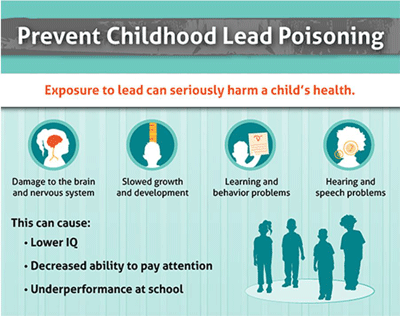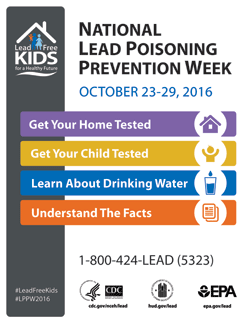Prevent Children’s Exposure to Lead
 Lead poisoning can be prevented. The key is to keep children from coming in contact with lead. If children are lead poisoned they must be treated. Learn how to prevent children’s exposure to lead.
Lead poisoning can be prevented. The key is to keep children from coming in contact with lead. If children are lead poisoned they must be treated. Learn how to prevent children’s exposure to lead.
There are many ways parents can reduce children’s exposure to lead before they are harmed. Lead hazards in a child’s environment must be identified and controlled or removed safely. Lead is invisible to the naked eye and has no smell.
Common Ways Children Can Come in Contact with Lead
Young children often put toys, fingers, and other objects in their mouth as part of their normal development. This may put them in contact with lead paint or dust.
One common way children can be exposed to lead are chips and particles of old lead paint. Children can be directly exposed to lead from paint if they swallow paint chips. But exposure is more common from swallowing house dust or soil contaminated by leaded paint. This happens when lead paint chips get ground into tiny bits that become part of the dust and soil in and around homes; for example, when leaded paint is old or worn or is subject to constant rubbing (as on doors and windowsills and wells). In addition, lead can be scattered when paint is disturbed during destruction, remodeling, paint removal, or preparation of painted surfaces for repainting.

Exposure to lead can seriously harm a child’s health.
Lead paint or dust are not the only ways children can come in contact with lead. Thirty percent of lead-poisoned children in certain areas across the United States may have been poisoned by other sources. These sources include
- traditional home health remedies such as azarcon and greta, which are used for upset stomach or indigestion in the Hispanic community;
- imported candies;
- imported toys and toy jewelry;
- imported cosmetics;
- pottery and ceramics;
- drinking water contaminated by lead leaching from lead pipes, solder, brass fixtures, or valves; and
- consumer products, including tea kettles and vinyl miniblinds.
A variety of work and hobby activities expose adults to lead, including using an indoor firing range, making home repairs, remodeling a home, and making pottery. When adults whose jobs expose them to lead wear their work clothes home or wash them with the family laundry, their families can be exposed to lead. Families can also be exposed when adults bring scrap or waste material home from work.
Get Treatment if You Think Your Child Has Been in Contact with Lead
If you think your child has been in contact with lead, contact your child’s health care provider. He or she can help you decide whether to test your child’s blood to see if it has high levels of lead.
A blood lead test is the only way to find out if your child has a high lead level. Most children with high levels of lead in their blood have no symptoms.
Your child’s health care provider can recommend treatment if your child has been exposed to lead.
See frequently asked questions about lead and possible lead exposure.
For more information on sources of lead exposure and prevention tips, please visit our webpage or call CDC-INFO at 1-800-CDC-INFO (232-4636).

National Lead Poisoning Prevention Week 2016
National Lead Poisoning Prevention Week: Lead-Free Kids for a Healthy Future
October 23-29 is National Lead Poisoning Prevention Week. Childhood lead poisoning is considered the most preventable environmental disease of young children. Approximately half a million U.S children ages 1-5 have blood lead levels above the blood lead value at which CDC recommends public health actions be initiated.
National Lead Poisoning Prevention Week occurs every year during the last full week in October. Many states and communities offer free blood lead testing and hold education and awareness events. For more information about National Lead Poisoning Prevention Week activities in your area, please contact your state or local health department.
View the National Lead Poisoning Prevention Week Campaign Toolkit created by CDC and our federal partners to encourage information sharing, collaboration, and promotion of lead poisoning prevention activities.
- Page last reviewed: October 24, 2016
- Page last updated: October 24, 2016
- Content source:
- National Center for Environmental Health
- Page maintained by: Office of the Associate Director for Communication, Digital Media Branch, Division of Public Affairs




 ShareCompartir
ShareCompartir